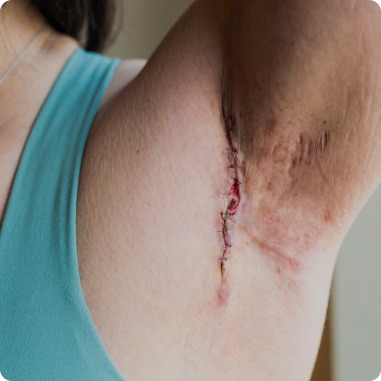
HS:
Underrecognized,
Underdiagnosed,
Under the Radar1
Actual patient living with HS
Hidradenitis suppurativa (HS) is mistakenly thought of as a rare disease.
The truth?
HS affects an estimated 0.1-1% of the US population—up to 3.3 million people.2
HS is
characterized by nodules, abscesses, and scarring
often misidentified for skin conditions like acne or folliculitis
mistreated because of years of misdiagnoses3
Let’s listen to Cydney as she shares her story of living with HS.
Who is the typical HS patient?
HS can affect people of every gender, race, and body type. Still, some people are at greater risk for developing HS. This includes young adults, females, African Americans, and those who are overweight.2,4
Gender2
3x
higher risk for females
Some studies suggest a link between HS flare-ups and sex hormones, like estrogen and progesterone. So, HS flare-ups may be more common in life stages involving hormonal changes, such as during puberty, menstruation, pregnancy, or menopause.

Age2
Onset usually occurs in a person's 20s and 30s.

Race2
While HS can affect anyone, African Americans have a 3x higher prevalence compared to white patients.
African American patients living with HS are also more likely to experience greater disease severity, more emergency department visits, more hospitalizations, and more surgeries than non-Hispanic white patients.5

Weight6
Patients with HS are 4x more likely to have a body mass index (BMI) ≥30 kg/m2 vs the general population.
Smoking7
Although no causal association has been established, a strong link exists between smoking and HS.
Approximately 90% of patients are current or former smokers.8

Family history9
Nearly one-third of patients with HS have a family history of HS.

Detect HS earlier
Diagnosing HS:
A common miss, multiplied
It takes patients with symptoms an average of 10 years and more than 3 providers before they finally receive an HS diagnosis. And some patients see up to 10 providers by the time they are accurately diagnosed.3,10,11
More than 8 out of 10 patients with HS receive at least one misdiagnosis, and the average number of misdiagnoses is ~3. Generally speaking, the length of delay in diagnosis corresponds with the number of misdiagnoses.3
Percentage of specific misdiagnoses before confirming HS3

The most common misdiagnoses are abscesses, ingrown hairs, and folliculitis.3
Delays in accurate diagnosis contribute to disease progression and development of additional comorbid conditions.3 Both can create long-lasting, negative effects on a patient’s quality of life.3
A longer diagnostic delay leads to more challenges

Actual patient living with HS
HS severity at diagnosis
In fact, ~7 of 10 patients may have moderate-to-severe HS by the time they receive a diagnosis.12

Actual patient living with HS
Number of surgical interventions
Roughly 75% of patients with a delayed diagnosis experience at least one surgical intervention.3

Actual patient living with HS
Number of comorbid conditions13,14
A greater number of comorbidities may develop with a delay in diagnosis of an inflammatory disease such as HS.3
- Musculoskeletal system disorders (spondyloarthritis)
- Metabolic disorders, including type 2 diabetes
- Polycystic ovary syndrome (PCOS)
- Mental health disorders, major depressive disorder (MDD), substance use disorder (SUD)
- Inflammatory bowel disease
To prevent irreversible damage from this devastating disease, it is essential to identify the underlying factors for diagnostic delay and to capture the “window of opportunity” in a timely manner.15
It might appear harmless.
But something bigger is lurking under the surface.
In a mild disease state, HS lesions primarily occur after the occlusion of a hair follicle (follicular hyperkeratosis) triggers a dysregulated innate and adaptive inflammatory apocrine gland response causing dilation of the hair follicles.16,17 IL-17 A/F, among other inflammatory cytokines, induce the expression of a broad range of proinflammatory chemokines, including CXCL1/6/8 and GCSF. This drives neutrophilic granulocyte migration to the follicular site, perpetuating inflammation and leading to follicular rupture and inflammatory nodule, abscess formation, and scarring.16,17 At this point, the disease is considered moderate.16 Severe HS occurs when chronic inflammation and the imbalance of fibrotic factors cause diffuse or interconnected sinus tract and abscess formation.16
CXCL=chemokine (C-X-C motif) ligand. GCSF=granulocyte colony-stimulating factor. IL=interleukin.
For patients with HS, diagnostic delays and misconceptions around what causes it can compound intense feelings of shame and embarrassment.1
It is crucial to talk with patients and be clear that they are not to blame for their disease. While the cause of HS is uncertain, it is important for patients to understand what HS is not.18,19
Help patients recognize:
HS is not
an infectious condition.
contagious.
sexually transmitted.
a result of poor hygiene.
their fault.
References
- Vlassova N, Kuhn D, Okoye GA. Hidradenitis suppurativa disproportionately affects African Americans: a single-center retrospective analysis. Acta Derm Venereol. 2015;95(8):990-1.
- Garg A, Kirby JS, Lavian J, et al. Sex- and age-adjusted population analysis of prevalence estimates for hidradenitis suppurativa in the United States. JAMA Dermatol. 2017;153(8):760-764.
- Kokolakis G, Wolk K, Schneider-Burrus S, et al. Delayed diagnosis of hidradenitis suppurativa and its effect on patients and healthcare system. Dermatology. 2020;236(5):421-430.
- Alikhan A, Sayed C, Alavi A, et al. North American clinical management guidelines for hidradenitis suppurativa: a publication from the United States and Canadian Hidradenitis Suppurativa Foundations: part I: diagnosis, evaluation, and the use of complementary and procedural management. J Am Acad Dermatol. 2019;81(1):76-90.
- Ulschmid C, Serrano L, Wu R, et al. African American race is a risk factor for severe hidradenitis suppurativa. Int J Dermatol. 2023;62(5):657-663.
- Choi F, Lehmer L, Ekelem C, Mesinkovska NA. Dietary and metabolic factors in the pathogenesis of hidradenitis suppurativa: a systematic review. Int J Dermatol. 2020;59(2):143-153.
- Garg A, Papagermanos V, Midura M, Strunk A. Incidence of hidradenitis suppurativa among tobacco smokers: a population-based retrospective analysis in the U.S.A. Br J Dermatol. 2018;178(3):709-714.
- Kurzen H, Kurzen M. Secondary prevention of hidradenitis suppurativa. Dermatol Reports. 2019;11(2):8243.
- Bruinsma RL, Fajgenbaum K, Yang Y, et al. Assessment of familial risk in patients with hidradenitis suppurativa. Br J Dermatol. 2021;184(4):753-754.
- Shah M, Sachdeva M, Alavi A. The importance of early diagnosis and treatment in hidradenitis suppurativa: case report and literature review. J Clin Cosmet Dermatol. 4(2): dx.doi.org/10.16966/2576-2826.151
- Loget J, et al. Misdiagnosis of hidradenitis suppurativa continues to be a major issue. The R-ENS Verneuil study. Ann Dermatol Venereol. 2018;145(5):331-338.
- Ingram JR, Bettoli V, Espy JI, et al. Unmet clinical needs and burden of disease in hidradenitis suppurativa: real-world experience from EU5 and US. J Eur Acad Dermatol Venereol. 2022;36(9):1597-1605.
- Garg A, Malviya N, Strunk A, et al. Comorbidity screening in hidradenitis suppurativa: evidence-based recommendations from the US and Canadian Hidradenitis Suppurativa Foundations. J Am Acad Dermatol. 2022;86(5):1092-1101.
- Tzellos T, Zouboulis CC. Review of comorbidities of hidradenitis suppurativa: implications for daily clinical practice. Dermatol Ther (Heidelb). 2020;10(1):63-71. doi: 10.1007/s13555-020-00354-2. Epub 2020 Jan 18. Erratum in: Dermatol Ther (Heidelb). 2020;10(3):523.
- Krueger JG, Frew J, Jemec GBE, et al. Hidradenitis suppurativa: new insights into disease mechanisms and an evolving treatment landscape. Br J Dermatol. Published online September 16, 2023.
- Scala E, Cacciapuoti S, Garzorz-Stark N, et al. Hidradenitis suppurativa: where we are and where we are going. Cells. 2021;10(8):1-19.
- Wolk K, Join-Lambert O, Sabat R. Aetiology and pathogenesis of hidradenitis suppurativa. Br J Dermatol. 2020;183(6):999-1010.
- Lee EY, Alhusayen R, Lansang P, et al. What is hidradenitis suppurativa? Can Fam Physician. 2017;63(2):114-120.
- Ring HC, Thorsen J, Saunte DM, et al. The follicular skin microbiome in patients with hidradenitis suppurativa and healthy controls. JAMA Dermatol. 2017 1;153(9):897-905.